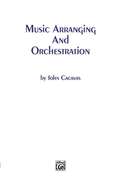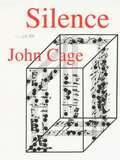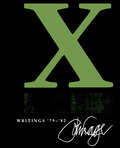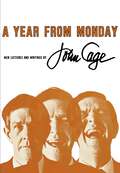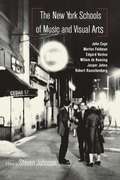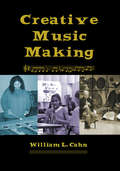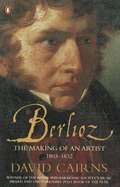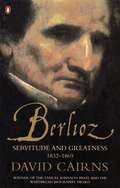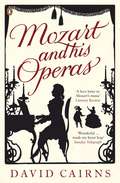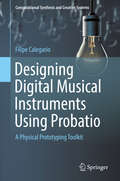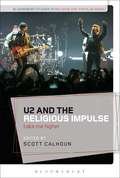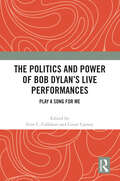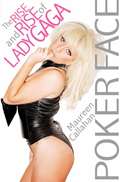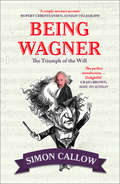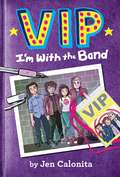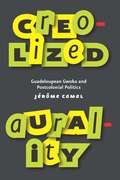- Table View
- List View
Music Arranging And Orchestration
by John CacavasOrchestrating is a highly complex technique and to many, even those with academic training, a mystery fraught with a labyrinth of hazards. What is required, along with innate talent and general musicality, is the practical "know how." This is hard to achieve without actual professional experience and contact with "live" orchestras. To this end, John Cacavas contributes his extensive experience and ability with a practical approach to the practical problems of orchestrating. It is in this context most orchestrators must function, and to whom this book should be of benefit. The author has been a "musical activist" in all the varied aspects of instrumental combination from the "classical" to the "contemporary," and in the diverse application of his skills in all the media that utilize music and "orchestrations."
M Writings;: '67-'72 (pdf)
by John CageMainly mesostics inspired by music, mushrooms, Marcel Duchamp, Merce Cunningham, Marshall McCluhan, etc. and includes "Mureau"-composed from the writings of Henry David Thoreau.
The Selected Letters of John Cage
by John CageThis selection of over five hundred letters gives us the life of John Cage with all the intelligence, wit, and inventiveness that made him such an important and groundbreaking composer and performer. The missives range from lengthy reports of his early trips to Europe in the 1930s through his years with the dancer Merce Cunningham, and shed new light on his growing eminence as an iconic performance artist of the American avant-garde. Cage's joie de vivre resounds in these letters—fully annotated throughout—in every phase of his career, and includes correspondence with Peter Yates, David Tudor, and Pierre Boulez, among others. Above all, they reveal his passionate interest in people, ideas, and the arts. The voice is one we recognize from his writings: singular, profound, irreverent, and funny. Not only will readers take pleasure in Cage's correspondence with and commentary about the people and events of a momentous and transformative time in the arts, they will also share in his meditations on the very nature of art. A deep pleasure to read, this volume presents an extraordinary portrait of a complex, brilliant man who challenged and changed the artistic currents of the twentieth century.
Silence : lectures and writings (PDF)
by Cage JohnJohn Cage, a leading figure of the American musical avant-garde and lecturer and writer extraordinary, dedicated himself to the search for new horizons in musical composition. His method of composition: an amalgam of chance operations, latitude in performace, the use of electronic sound and the inclusion of ambient noise. His aim: to increase the territory of his art and to celebrate the richness of life. Silence is a collection of some of the essays and lectures that have made John Cage's name synonymous with all that is unpredictable and exciting in contemporary miusic. Outrageous they may be, but to anyone who is receptive to new ideas, to fresh and original ways of looking at and listening to things, they are a mine of fascinating discovery. And, as Cage fans will expect, the book also contains a wealth of handy information on collecting mushrooms, fishing through ice, and so on, as well as many anecdotes and Zen-type stories which illustrate Cage's exuberant artistic pre-occupations. For everywhere in this mighty explosion of ideas can be heard the still, small voice of the poet, telling with fervour his amazement at creation, when 'everything was given away'.
The New York Schools of Music and the Visual Arts
by John Cage Morton Feldman Edgard Varèse Willem De Kooning Jasper Johns Robert RauschenbergMusicians and artists have always shared mutual interests and exchanged theories of art and creativity. This exchange climaxed just after World War II, when a group of New York-based musicians, including John Cage, Morton Feldman, Earle Brown, and David Tudor, formed friendships with a group of painters. The latter group, now known collectively as either the New York School or the Abstract Expressionists, included Jackson Pollock, Willem deKooning, Robert Motherwell, Mark Rothko, Barnett Newman, Clyfford Still, Franz Kline, Phillip Guston, and William Baziotes. The group also included a younger generation of artists-particularly Robert Rauschenberg and Jasper Johns-that stood somewhat apart from the Abstract Expressionists. This group of painters created what is arguably the first significant American movement in the visual arts. Inspired by the artists, the New York School composers accomplished a similar feat. By the beginning of the 1960s, the New York Schools of art and music had assumed a position of leadership in the world of art. For anyone interested in the development of 20th century art, music, and culture, The New York Schools of Music and Art will make for illuminating reading.
MUSICAGE: CAGE MUSES on Words * Art * Music
by John Cage Joan Retallack"I was obliged to find a radical way to work — to get at the real, at the root of the matter," John Cage says in this trio of dialogues, completed just days before his death. His quest for the root of the matter led him beyond the bounds of the conventional in all his musical, written, and visual pieces. The resulting expansion of the definition of art — with its concomitant emphasis on innovation and invention—earned him a reputation as one of America's most influential contemporary artists.Joan Retallack's conversations with Cage represent the first consideration of his artistic production in its entirety, across genres. Informed by the perspective of age, Cage's comments range freely from his theories of chance and indeterminate composition to his long-time collaboration with Merce Cunningham to the aesthetics of his multimedia works. A composer for whom the whole world — with its brimming silences and anarchic harmonies — was a source of music, Cage once claimed, "There is no noise, only sounds." As these interviews attest, that penchant for testing traditions reached far beyond his music. His lifelong project, Retallack writes in her comprehensive introduction, was "dislodging cultural authoritarianism and gridlock by inviting surprising conjunctions within carefully delimited frameworks and processes." Consummate performer to the end, Cage delivers here just such a conjunction — a tour de force that provides new insights into the man and a clearer view of the status of art in the 20th century.
Creative Music Making
by William L CahnMost musicians focus on learning technique (learning how to play an instrument), rather than on developing an individual, unique voice. Creative Music Making focuses on the creative development of musicians from all levels of experience and in all styles of music. Based on the author's experience leading workshops for performers around the world, the easy-to-follow exercises in this text will enable any musician--from beginner to professional--to improve creativity and self-expression. Creative Music Making will open the ears of all musicians, vocalists or instrumentalists, in classical, popular, or jazz styles, to a world of new possibilities.
Creative Music Making
by William L CahnMost musicians focus on learning technique (learning how to play an instrument), rather than on developing an individual, unique voice. Creative Music Making focuses on the creative development of musicians from all levels of experience and in all styles of music. Based on the author's experience leading workshops for performers around the world, the easy-to-follow exercises in this text will enable any musician--from beginner to professional--to improve creativity and self-expression. Creative Music Making will open the ears of all musicians, vocalists or instrumentalists, in classical, popular, or jazz styles, to a world of new possibilities.
Berlioz: The Making of an Artist 1803-1832
by David CairnsNo artist's achievement connects more directly with early experience than that of Berlioz. David Cairns draws on a wealth of family papers to recreate in authentic and intimate detail the provincial milieu of Berlioz's boyhood, showing how the son of a village doctor was already transforming himself into the composer of the Fantastic Symphony. Berlioz's desperate attempts to win his father's approval for his vocation, his struggles to establish himself on the Parisian musical scene, and his passionate pursuit of love are all brought vividly to life in this first volume of David Cairn's award-winning biography.
Berlioz: Servitude and Greatness 1832-1869
by David CairnsBerlioz was one of the towering figures of Romanticism: not only was he a great and revolutionary composer, but also the finest composer of his day and an outstanding critic and writer. Yet throughout his life he struggled for money and his music was persistently reviled in his native France. With exceptional insight and sympathy, David Cairns draws together the major strands of Berlioz's life: his tempestuous marriage to the actress Harriet Smithson; the genesis of his famous works, including the Requiem, Romeo and Juliet and his crowning masterpiece The Trojans; his friendships with Mendelssohn, Liszt, Princess Wittgenstein and Wagner; and, finally, his last years haunted once again by personal tragedy. Here, as never before, is Berlioz the artist - and the man.
Mozart and His Operas
by David CairnsDavid Cairns weaves a brilliantly engaging narrative which puts Mozart’s operas in the context of his life, showing how they illuminate his creativity as a whole. Mozart’s unusual childhood as a musical prodigy touring Europe as a performer from an early age is well known. But even more remarkable is that the genius grew up, surviving his unnatural early years and producing works of increasing maturity and originality. Using the operas as his guide, Cairns traces the steady deepening of Mozart’s musical style from his beginnings as a child prodigy, through his coming of age with what Cairns sees as the most Romantic and forward-looking of all Mozart’s operas, Idomeneo, the later genius displayed in the three comic operas, The Marriage of Figaro, Don Giovanni, and Così fan tutte, and in The Magic Flute, the final and greatest triumph of his career.
Joaquín Rodrigo: Writings on Music
by Raymond Calcraft Elizabeth MatthewsJoaquín Rodrigo, Spain's leading composer of the second half of the twentieth century, was also a writer of considerable distinction. In addition to his 170 compositions in almost every musical form, including the world-famous Concierto de Aranjuez for guitar and orchestra, he published articles and critical reviews throughout his working life. This volume makes available Rodrigo's writings to English-speaking readers throughout the world. The generous selection reveals an outstanding critical mind, equally illuminating on the main developments in the history of classical music and its most important composers, from Bach and Mozart to Verdi and Puccini, as well as Rodrigo's contemporaries. Rodrigo’s writings also cover many aspects of the culture and music of Spain and the country's major composers, as well as being an invaluable guide to an understanding and appreciation of Rodrigo's own works. The composer's style of writing is extremely varied, by turns incisive, eloquent, poetic, or delightfully humorous. Given the worldwide fame and popularity of his music, the availability in English of a large number of the composer's many articles and critical reviews will be of the greatest interest to musicians, scholars, music critics, and music-lovers alike.
Joaquín Rodrigo: Writings on Music
by Raymond Calcraft Elizabeth MatthewsJoaquín Rodrigo, Spain's leading composer of the second half of the twentieth century, was also a writer of considerable distinction. In addition to his 170 compositions in almost every musical form, including the world-famous Concierto de Aranjuez for guitar and orchestra, he published articles and critical reviews throughout his working life. This volume makes available Rodrigo's writings to English-speaking readers throughout the world. The generous selection reveals an outstanding critical mind, equally illuminating on the main developments in the history of classical music and its most important composers, from Bach and Mozart to Verdi and Puccini, as well as Rodrigo's contemporaries. Rodrigo’s writings also cover many aspects of the culture and music of Spain and the country's major composers, as well as being an invaluable guide to an understanding and appreciation of Rodrigo's own works. The composer's style of writing is extremely varied, by turns incisive, eloquent, poetic, or delightfully humorous. Given the worldwide fame and popularity of his music, the availability in English of a large number of the composer's many articles and critical reviews will be of the greatest interest to musicians, scholars, music critics, and music-lovers alike.
Designing Digital Musical Instruments Using Probatio: A Physical Prototyping Toolkit (Computational Synthesis and Creative Systems)
by Filipe CalegarioThe author presents Probatio, a toolkit for building functional DMI (digital musical instruments) prototypes, artifacts in which gestural control and sound production are physically decoupled but digitally mapped. He uses the concept of instrumental inheritance, the application of gestural and/or structural components of existing instruments to generate ideas for new instruments. To support analysis and combination, he then leverages a traditional design method, the morphological chart, in which existing artifacts are split into parts, presented in a visual form and then recombined to produce new ideas. And finally he integrates the concept and the method in a concrete object, a physical prototyping toolkit for building functional DMI prototypes: Probatio. The author's evaluation of this modular system shows it reduces the time required to develop functional prototypes. The book is useful for researchers, practitioners, and graduate students in the areas of musical creativity and human-computer interaction, in particular those engaged in generating, communicating, and testing ideas in complex design spaces.
U2 and the Religious Impulse: Take Me Higher (Bloomsbury Studies in Religion and Popular Music)
by Scott CalhounU2 and the Religious Impulse examines indications in U2's music and performances that the band work at conscious and subconscious levels as artists who focus on matters of the spirit, religious traditions, and a life guided by both belief and doubt. U2 is known for a career of stirring songs, landmark performances and for its interest in connecting with fans to reach a higher power to accomplish greater purposes. Its success as a rock band is unparalleled in the history of rock 'n' roll's greatest acts. In addition to all the thrills one would expect from entertainers at this level, U2 surprises many listeners who examine its lyrics and concert themes by having a depth of interest in matters of human existence more typically found in literature, philosophy and theology. The multi-disciplinary perspectives presented here account for the durability of U2's art and offer informed explanations as to why many fans of popular music who seek a connection with a higher power find U2 to be a kindred spirit. This study will be of interest to scholars and students of religious studies and musicology, interested in religion and popular music, as well as religion and popular culture more broadly.
U2 and the Religious Impulse: Take Me Higher (Bloomsbury Studies in Religion and Popular Music)
by Scott CalhounU2 and the Religious Impulse examines indications in U2's music and performances that the band work at conscious and subconscious levels as artists who focus on matters of the spirit, religious traditions, and a life guided by both belief and doubt. U2 is known for a career of stirring songs, landmark performances and for its interest in connecting with fans to reach a higher power to accomplish greater purposes. Its success as a rock band is unparalleled in the history of rock 'n' roll's greatest acts. In addition to all the thrills one would expect from entertainers at this level, U2 surprises many listeners who examine its lyrics and concert themes by having a depth of interest in matters of human existence more typically found in literature, philosophy and theology. The multi-disciplinary perspectives presented here account for the durability of U2's art and offer informed explanations as to why many fans of popular music who seek a connection with a higher power find U2 to be a kindred spirit. This study will be of interest to scholars and students of religious studies and musicology, interested in religion and popular music, as well as religion and popular culture more broadly.
The Politics and Power of Bob Dylan’s Live Performances: Play a Song for Me
by Erin C Callahan Court CarneyEphemeral by nature, the concert setlist is a rich, if underexplored, text for scholarly research. How an artist curates a show is a significant aspect of any concert’s appeal. Through the placement of songs, variations in order, or the omission of material, Bob Dylan’s setlists form a meta-narrative speaking to the power and significance of his music. These essays use the setlists from concerts throughout Dylan’s career to study his approach to his material from the 1960s to the 2020s. These chapters, from various disciplinary perspectives, illustrate how the concert setlist can be used as a source to explore many aspects of Dylan’s public life. Finally, this collection provides a new method to examine other musicians across genres with an interdisciplinary approach to setlists and the selectivity of performance. Unique in its approach and wide-ranging scholarly methodology, this book deepens our understanding of Bob Dylan, the performer.
Poker Face: The Rise and Rise of Lady Gaga
by Maureen CallahanIn just a two-year span, Stefani Germanotta, a struggling performer in New York's Lower East Side burlesque scene, has become the global demographic-smashing pop icon known as Lady Gaga. She is a once-in-a-decade artist, a gifted singer, composer, designer, and performance artist who mixes high and low culture, the avant-garde with the accessible, authenticity with artifice.Who is Lady Gaga? She is a twenty-five-year-old woman whose stage mantra--"I'm a free bitch!"--is the polar opposite of who she is offstage: isolated, insecure, and unable to be alone. She is an outrÉ artist who wanted to be a sensitive singer-songwriter. She is a woman who says no man can ever compete with her career, but who goes back and forth with the ex-boyfriend who said she was too ambitious. She claims not to care what people think, but spends her downtime online, reading what people have to say about her. She claims to be a con artist and utterly authentic. She is never less than compelling.Based on more than fifty original interviews with friends, employees, rivals, and music industry veterans, Poker Face is the first in-depth biography of the extraordinary cultural phenomenon that is Lady Gaga.
Creolized Aurality: Guadeloupean Gwoka and Postcolonial Politics (Chicago Studies in Ethnomusicology)
by Jérôme CamalIn the Caribbean island of Guadeloupe, the complex interplay between anticolonial resistance and accommodation resounds in its music. Guadeloupean gwoka music—a secular, drum-based tradition—captures the entangled histories of French colonization, movements against it, and the uneasy process of the island’s decolonization as an overseas territory of France. In Creolized Aurality, Jérôme Camal demonstrates that musical sounds and practices express the multiple—and often seemingly contradictory—cultural belongings and political longings that characterize postcoloniality. While gwoka has been associated with anti-colonial activism since the 1960s, in more recent years it has provided a platform for a cohort of younger musicians to express pan-Caribbean and diasporic solidarities. This generation of musicians even worked through the French state to gain UNESCO heritage status for their art. These gwoka practices, Camal argues, are “creolized auralities”—expressions of a culture both of and against French coloniality and postcoloniality.
Creolized Aurality: Guadeloupean Gwoka and Postcolonial Politics (Chicago Studies in Ethnomusicology)
by Jérôme CamalIn the Caribbean island of Guadeloupe, the complex interplay between anticolonial resistance and accommodation resounds in its music. Guadeloupean gwoka music—a secular, drum-based tradition—captures the entangled histories of French colonization, movements against it, and the uneasy process of the island’s decolonization as an overseas territory of France. In Creolized Aurality, Jérôme Camal demonstrates that musical sounds and practices express the multiple—and often seemingly contradictory—cultural belongings and political longings that characterize postcoloniality. While gwoka has been associated with anti-colonial activism since the 1960s, in more recent years it has provided a platform for a cohort of younger musicians to express pan-Caribbean and diasporic solidarities. This generation of musicians even worked through the French state to gain UNESCO heritage status for their art. These gwoka practices, Camal argues, are “creolized auralities”—expressions of a culture both of and against French coloniality and postcoloniality.
